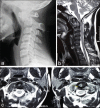Odontoid fracture with missed diagnosis of Transverse Atlantal Ligament (TAL) injury resulting in late-onset instability
- PMID: 30595961
- PMCID: PMC6287336
- DOI: 10.4103/sni.sni_315_18
Odontoid fracture with missed diagnosis of Transverse Atlantal Ligament (TAL) injury resulting in late-onset instability
Abstract
Background: Concurrent injuries to both the odontoid and transverse atlantal ligament are rare and can be easily missed. Failure to diagnose both lesions potentially leads to the late onset of sagittal plane instability and acute myelopathy. Here, we present a patient with an odontoid fracture whose transverse atlantal ligament (TAL) injury was originally missed on magnetic resonance imaging (MRI) and computed tomography (CT) scans. He later developed atlantoaxial instability requiring surgery.
Case description: A 17-year-old male presented with neck pain, restricted cervical range of motion, but a normal neurological exam following a motor vehicle accident. The original X-rays showed a moderately displaced type-3 odontoid fracture. Additional MRI and CT scans excluded ligamentous injury, and he was initially treated with 13 weeks of halo vest immobilization. Radiographs 5 months later showed an enlarged atlanto-dens interval (e.g., >3 mm); the diagnosis of an odontoid fracture with an accompanying TAL injury was established, following which the patient successfully underwent a posterior C1-C2 fusion.
Conclusion: Odontoid fractures require strict clinical and radiographic (X-ray, MRI, CT) surveillance to help rule out accompanying TAL injuries that may warrant surgical intervention.
Keywords: Atlantoaxial instability; odontoid; transverse atlantal ligament injury.
Conflict of interest statement
There are no conflicts of interest.
Figures






Similar articles
-
A retrospective review of fixation of C1 ring fractures--does the transverse atlantal ligament (TAL) really matter?Spine J. 2016 Mar;16(3):372-9. doi: 10.1016/j.spinee.2015.11.041. Epub 2015 Dec 1. Spine J. 2016. PMID: 26656168
-
"Rule of Spence" and Dickman's Classification of Transverse Atlantal Ligament Injury Revisited: Discrepancy of Prediction on Atlantoaxial Stability Based on Clinical Outcome of Nonoperative Treatment for Atlas Fractures.Spine (Phila Pa 1976). 2019 Mar 1;44(5):E306-E314. doi: 10.1097/BRS.0000000000002877. Spine (Phila Pa 1976). 2019. PMID: 30222691
-
Comparison of CT versus MRI measurements of transverse atlantal ligament integrity in craniovertebral junction injuries. Part 1: A clinical study.J Neurosurg Spine. 2016 Jun;24(6):897-902. doi: 10.3171/2015.9.SPINE13808. Epub 2016 Feb 26. J Neurosurg Spine. 2016. PMID: 26918572
-
Fifty years later: the "rule of Spence" is finally ready for retirement.J Neurosurg Spine. 2022 Feb 11;37(2):149-156. doi: 10.3171/2021.12.SPINE211188. Print 2022 Aug 1. J Neurosurg Spine. 2022. PMID: 35148514 Review.
-
Temporary fusionless posterior occipitocervical fixation for a proximal junctional type II odontoid fracture after previous C2-pelvis fusion: case report, description of a new surgical technique, and review of the literature.Eur Spine J. 2017 May;26(Suppl 1):243-248. doi: 10.1007/s00586-017-5093-8. Epub 2017 Apr 13. Eur Spine J. 2017. PMID: 28409288 Review.
References
-
- Bono CM, Carreras E. Rockwood and Green's Fractures in Adults. 7th ed. Philadelphia, PA: Wolters Kluwer, Lippincott Williams & Wilkins; 2010. Cervical spine fractures and dislocations; pp. 1313–77.
-
- Bransford RJ, Patt JC, Chapman JR. Odontoid fractures. In: Benzel EC, editor. The Cervical Spine. 5th ed. Philadelphia, PA: Wolters Kluwer, Lippincott Williams & Wilkins; 2012. pp. 632–64.
-
- Debernardi A, D’Aliberti G, Talamonti G, Villa F, Piparo M, Cenzato M. Traumatic (type II) odontoid fracture with transverse atlantal ligament injury: A controversial event. World Neurosurg. 2013;79:779–83. - PubMed
-
- Huang J, Qian B, Qiu Y, Yu Y, Ni HB. Surgical overreduction and hyperlordotic fusion of C1-C2 joint are associated with cervical sagittal malalignment. Arch Orthop Trauma Surg. 2017;137:1631–9. - PubMed
-
- Julien TD, Frankel B, Traynelis VC, Ryken TC. Evidence-based analysis of odontoid fracture management. Neurosurg Focus. 2000;8:e1. - PubMed
Publication types
LinkOut - more resources
Full Text Sources
Miscellaneous
